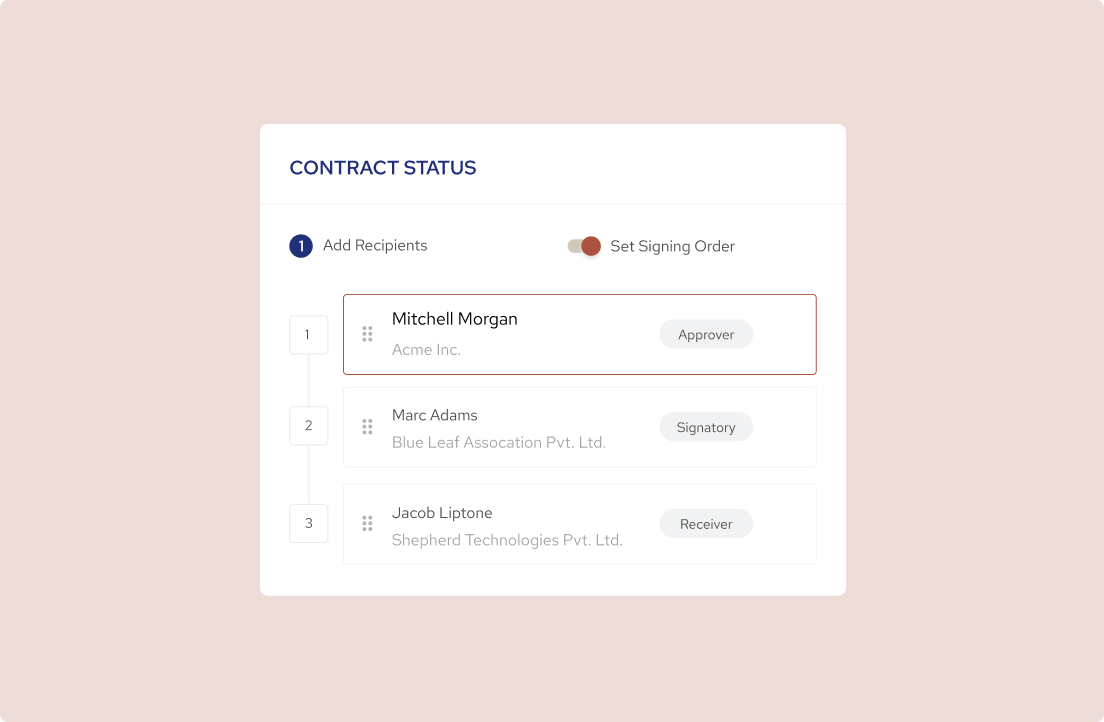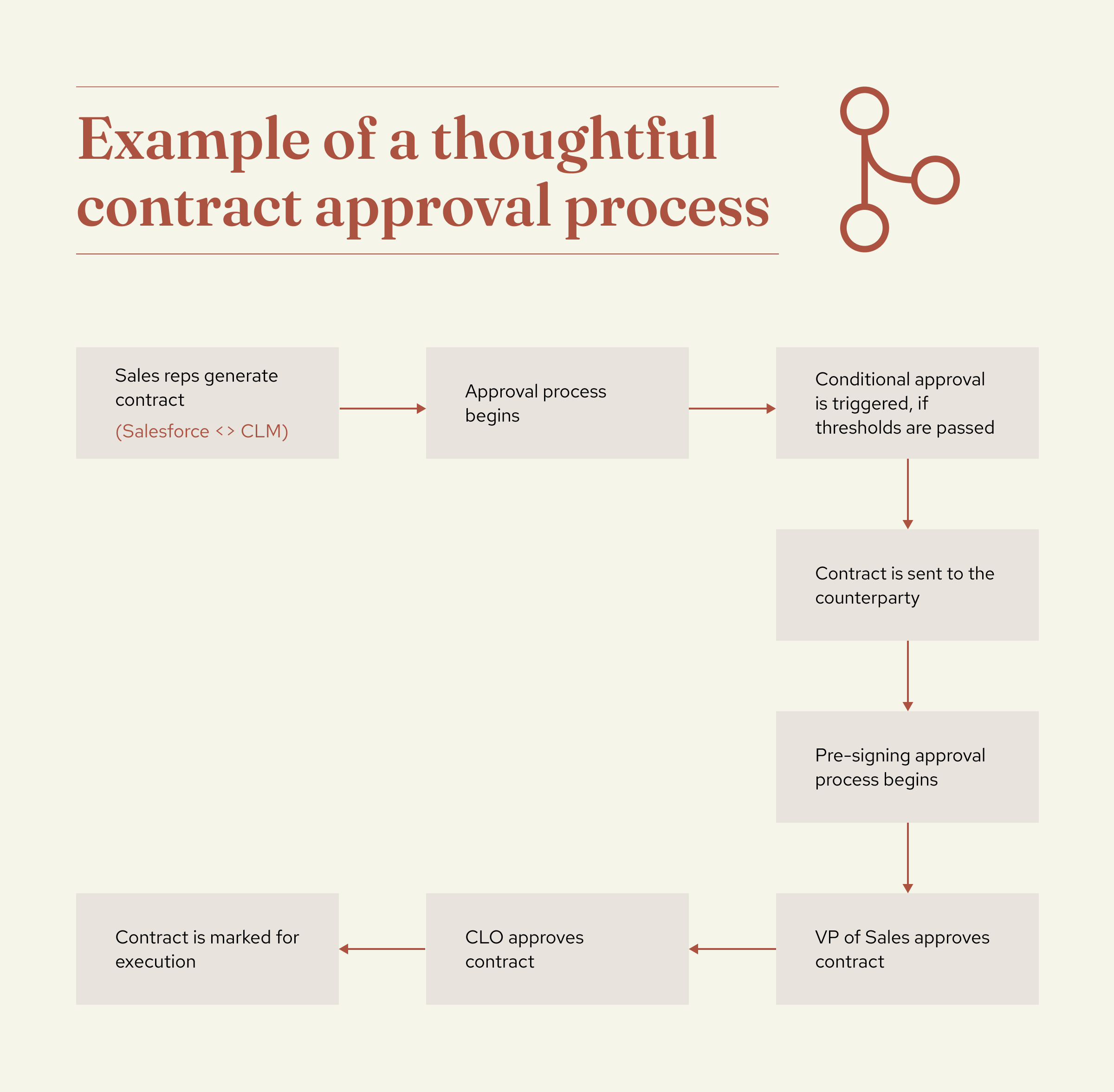For most companies, the contract approval process is riddled with inefficiencies and chaos. If you’re an in-house legal counsel, you know firsthand that approvals can be a major blocker when it comes to moving through the contract lifecycle.
That’s why it’s so important to have an efficient contract approval process in place that streamlines all the tasks involved, establishing transparency within the process and clear communication channels for flow of information.
Setting up this process can be a daunting task if you’re trying to bring cohesion to a confusing but established process in your organization. We’ve created a step-by-step guide to help you along on this endeavor, along with a template, examples, and insights from experts we've spoken with to give you real-life advice on how to get started.
Signs your contract approval process needs an overhaul
A well-defined process not only protects your organization's interests, but also helps ensure that contracts are handled in a consistent and timely manner. How do you know if your contract approval process needs to be streamlined? Here are a few signs:
- Contracts are frequently delayed or not approved within set timelines, or timelines are set accounting for delays and long approval times.
- There is a high rate of errors or mistakes in contracts, resulting in costly mistakes, rework, or disputes.
- There is a lack of clarity or consistency in the process, leading to confusion and inconsistency.
- There is a lack of transparency in the process, making it difficult to track the progress of contract reviews and approvals.
- There is no clear accountability, with no clear roles, ownership, and responsibilities for parties involved in the process.
- The process is inflexible and cannot accommodate changes or exceptions.
- The process is cumbersome and inefficient, resulting in unnecessary work or delays.
6 steps to set up a contract approval process that works
.png)
If you can recognize your organization in the signs outlined above, it’s imperative that you rethink your contract approval process. Don’t worry, we’ll help. Here’s how you can go about setting up an efficient contract approval process in just 6 steps.
“Legal has ultimately designed most of the contracts. There should be no deviation but stuff happens. So, we need some sort of approval matrix where every contract gets some kind of sign-off from legal. Then, depending on what kind of contract it is, there might be a technical person who will review the contract. From a budget perspective, it might go to finance. It is up to legal teams to create that sort of metric.”
— Head of Legal in the FinTech industry
#1 Identify stakeholders
The first thing you need to do is identify everyone involved in creating and approving contracts within your organization. This includes not just the individuals or departments involved within your current process but also those who should ideally have visibility into the process as well.
This may include:
- C-level executives, such as the CEO, CFO, CLO, etc.
- Contract managers
- Legal team
- Sales, procurement, and other relevant business teams
- Finance team, etc.
#2 Nail down the approval hierarchy
Once you’ve identified all the relevant stakeholders, it’s time to take stock of where on the approval hierarchy they lie. Who needs to be involved in every contract and who only needs to be brought in for the high-level deals?
Do all your contracts pass through your CEO? Do your low-priority contracts also require high-level approvals? Can you make it so only the high-priority contracts that need their approval will be sent to them? Answer these questions to figure out all the areas of improvement in your current approval chain and necessitate as few approvals as possible.
This doesn’t mean that there will be lesser supervision over contracts. Instead, you should thoughtfully consider what are the standards for your regular contracts and what would require further review over those pre-approved standards.
Set thresholds for contract values, contract terms, etc., and get preferred language as well as fallback language approved for clauses. On the basis of these guidelines, you will arrive at a proper hierarchy for approvals that will help you solve the roadblocks in your current process.
#3 Automate the contract review and approval chain
“A manual approval process makes approval tracking difficult and doesn’t provide a clear trail of who gave a sign off on the contract, which means you could miss getting crucial approvals and this may lead to costly mistakes."
– Diwyata Burbure
Senior Vice President - Legal Tech @SpotDraft
Figuring out an efficient approval process doesn’t stop at nailing down the approval hierarchy – now you have to build processes for effective flow of information and integrate it into your current workflow. Manually gaining approvals for contracts can be not only extremely time consuming but also leaves a lot of room for human error. During this step, you must automate the entire contract lifecycle and quash as many manual processes as possible.
You can do this with the help of a contract management software, which will help you automatically route contracts from one step to the next, gain approvals, and track the status of your contracts. This will streamline the process for all stakeholders, keep things all on one platform, provide visibility, and eliminate the risk of errors and mistakes.
The main aim of this step is to remove as much manual effort as possible and target all the inefficiencies in your current process.
#4 Communicate the process to all relevant parties
Now that you have an actionable plan for your contract approval process, it’s time to ensure that all parties involved in the process know exactly what to do and where to go. It’s important to clearly communicate that this new process is one that must be followed universally within the organization, and doing things any other way will not work. If needed, you can make this part of the KPIs to ensure this process is properly implemented.
Of course, this is where you also must ensure that sufficient training is provided on the new processes and tools to help drive adoption within the organization. Above all, it’s important to allow for an adjustment period and consistently take feedback on where things can be improved.
#5 Establish a system for tracking contract reviews and approvals
The next few months are going to be imperative in terms of tracking the efficiency of your new process. If you’ve got a CLM, it will provide access to crucial analytics and insights on your new contract approval workflow. Take particular note of turnaround times, rounds of negotiations and edits, and analytics on the contract lifecycle to understand the impact of the new process, learn how it might have affected your team’s productivity, and spot areas of further improvement.
Manually, this might be a bit tricky to achieve, but it can certainly be done with sufficient documentation and a clear buy-in from all stakeholders to stick to the outlined channels at all costs. However, the retrieval of this data might pose a greater problem without a software or system to track it for you.

#6 Review and update the process as needed
Finally, it’s essential that you monitor this process and periodically review it for possible inefficiencies and blockers, alongside taking in feedback from stakeholders. This way, you will be able to identify areas of improvement and make necessary updates.
3 best practices for an efficient contract approval process
Based on our conversations with legal leaders, customers and non-customers alike, we have arrived at some best practices that work for legal teams and should also help you ensure efficiency within your contract approval process.
#1 Automate approvals, requests, and tasks through a CLM
In today’s digital age, legal teams are increasingly facing high volumes of contracts and the pressure to perform at rapidly decreasing turnaround times. In such a case, it becomes essential for in-house teams to be equipped with digital tools to help them meet this pace head on.
A contract management software helps automate all those manual aspects of contract approvals that take the most time and help you reduce turnaround times. For example, you can set up a workflow that automatically routes approvals according to your decided hierarchy depending on the type of contract. Moreover, it will provide you with an audit log that shows you exactly who made changes to the contract, who it’s currently with, and what is the current status.

#2 Set thresholds for conditional approvals
“There is a stratification based on the contract value [at my organization]. We have set monetary thresholds. When the contract value exceeds that number, the contract goes through a strict review and approval process, and only certain authorized signatories can approve that contract."
— Nadia Louis Hermez
Legal Ops Manager, Next Insurance, Inc.
It’s inefficient to have every contract go through every stakeholder’s approval, as it creates unnecessary bottlenecks within the process. Instead, it’s better to arrive at certain thresholds that are acceptable for specific contracts, and when those thresholds are passed, automatic approvals can be triggered within your CLM for additional review.

#3 Use contract templates
Does your team manually generate every contract from scratch? Or maybe they duplicate similar contracts and then manually personalize each agreement every time? This not only leaves room for a lot of manual error, but also takes up time and resources that may have been better spent elsewhere.
A more productive way to generate high-volume contracts is to create pre-approved contract templates within a contract management system with access controls limiting contract editing. By simply filling out a questionnaire, your team members from various business functions can then independently generate contracts within seconds.

“Earlier, the purchasing department used to stand outside mine or the CEO's office to get purchase orders approved. This has been completely streamlined with SpotDraft, as they can now generate POs and automatically request approvals from key individuals in the hospital based on the nature of the request. For example, orders over a specific value are sent to the CEO as well as the MD for approval.
SpotDraft has also helped us eliminate misplacement of POs, so we don’t have to spend time hunting them down later. We are also getting our HR documents (agreements with consultants, nurses, other staff) on SpotDraft so that we have one source of truth for everything.”
—Dr. Anjana Sudheesan, Deputy Medical Superintendent, Apollo Adlux
A sample contract approval template that covers all the bases
#1 Generate/input contract into the CLM
The business teams generate contracts independently through pre-approved templates or input third-party paper to start the contracting process. Legal teams can also create editable contracts through the Editor on their CLM.

#2 Route contract for pre-send review and approval
The contract is sent for approval to internal stakeholders who will review the particulars of the contract, such as contract term, deal value, etc. Conditional approval for any additional review required will trigger whenever set thresholds are passed.

#3 Stakeholders review and provide input
Stakeholders approve, ask for revisions, disapprove, or ask for further context. Based on this, the contract can head for further review or go back to the user who created the contract to make the necessary revisions.

Obtain pre-sign approvals and route for signatures
Once the contract is approved internally, it’s sent to the counterparty for review and then routed for any approvals required to ready the contract for signing. The contract management system automatically prompts the relevant parties according to the set approval chain, ensuring all necessary approvals are obtained before the contract is finalized.

Example of a contract approval process set up by a SpotDraft customer

A company in the solar energy space has implemented a contract management system to automate their contract approval process. One type of contracts they’ve streamlined is the sales service agreements, to free up legal bandwidth and allow for greater efficiency. The template is integrated within Salesforce, their CRM, which allows sales reps to generate contracts directly within their preferred platform. From their CRM, they can get the contracting process started and route the contract for the necessary approvals.
Since this is a templatized contract with pre-approved thresholds for the contract value, term, etc., Sales does not usually need to get further approval from Legal or Finance before sending the contract to the counterparty for review. However, if the contract passes these thresholds, their contract management system automatically triggers additional approval from the relevant teams. The contract is then sent to the counterparty for their review.
For their pre-sign approval process, their CLM first sends a notification to the VP of Sales, gaining her approval before the e-signature process can be initiated. She then either approves or provides feedback on the contract. Since this is a templatized contract, it usually gets approved quickly. Once she approves the contract, the contract is automatically routed to the Chief Legal and Compliance Officer, and the same process is followed.
Once both the necessary approvals are obtained the contract is ready for execution, it’s routed for signatures from their President and CFO as well as the counterparties.
Streamline your contract approval process with SpotDraft
A streamlined contract approval process will help you protect your organization’s interests, ensure efficiency in operations, and position the legal team as a business enabler — not a blocker. SpotDraft helps you streamline your contracting process and get rid of the redundant tasks that plague modern legal teams operating on yesterday’s operation models.
Reach out to us to understand how SpotDraft can help you create a more efficient contract approval process within your organization. Request a demo today.





.png)


